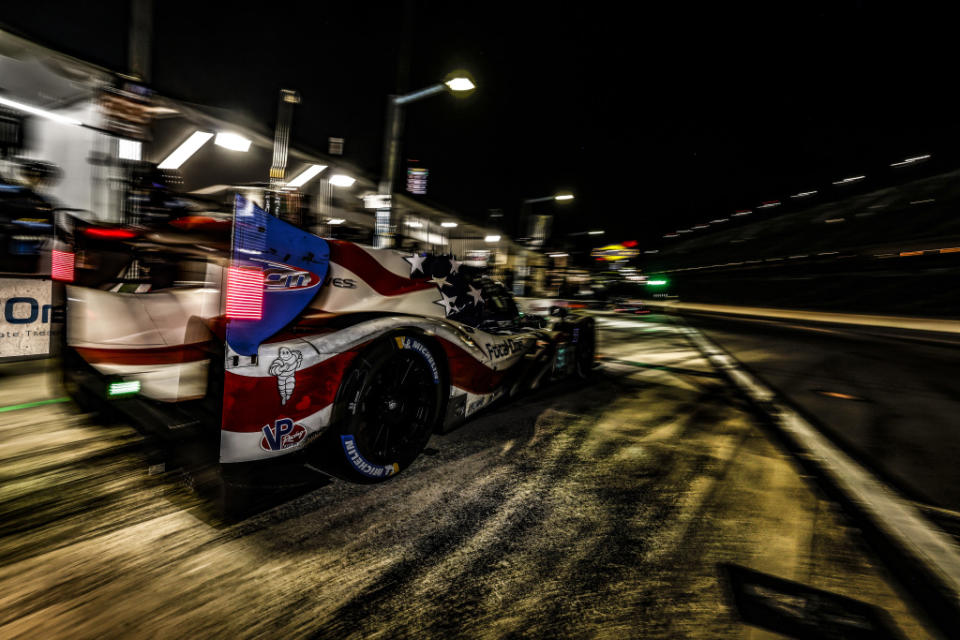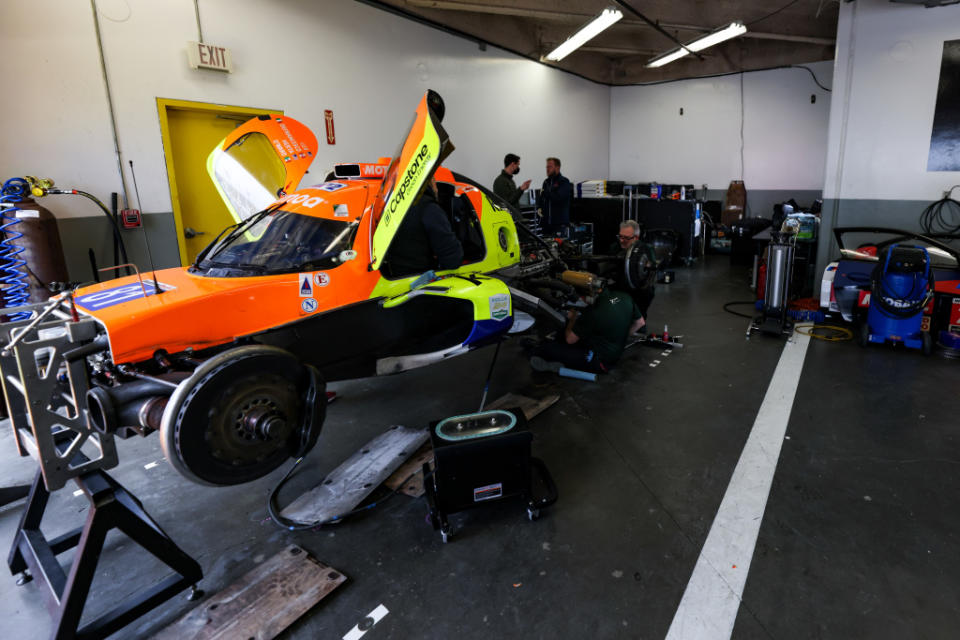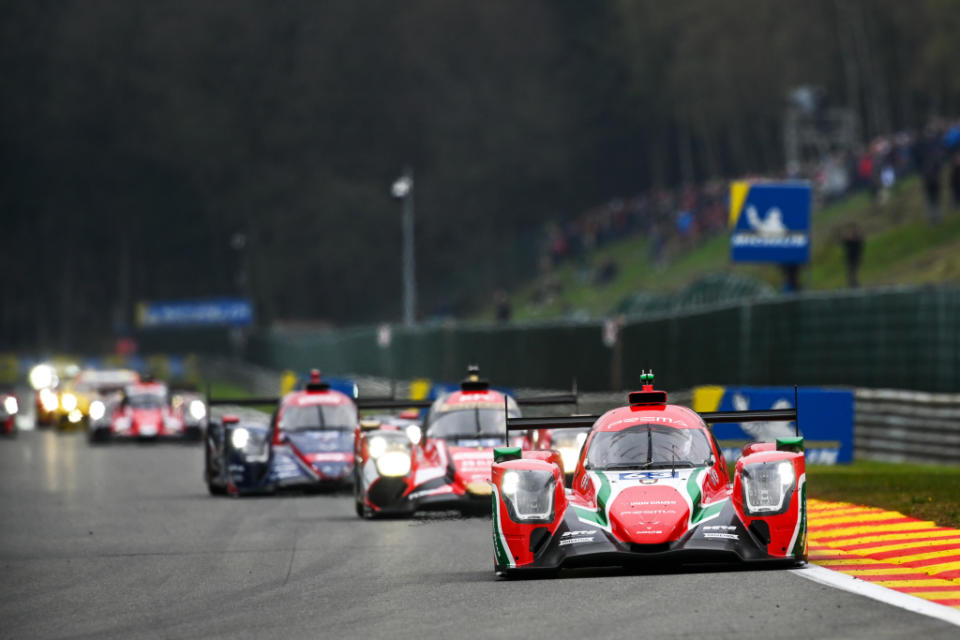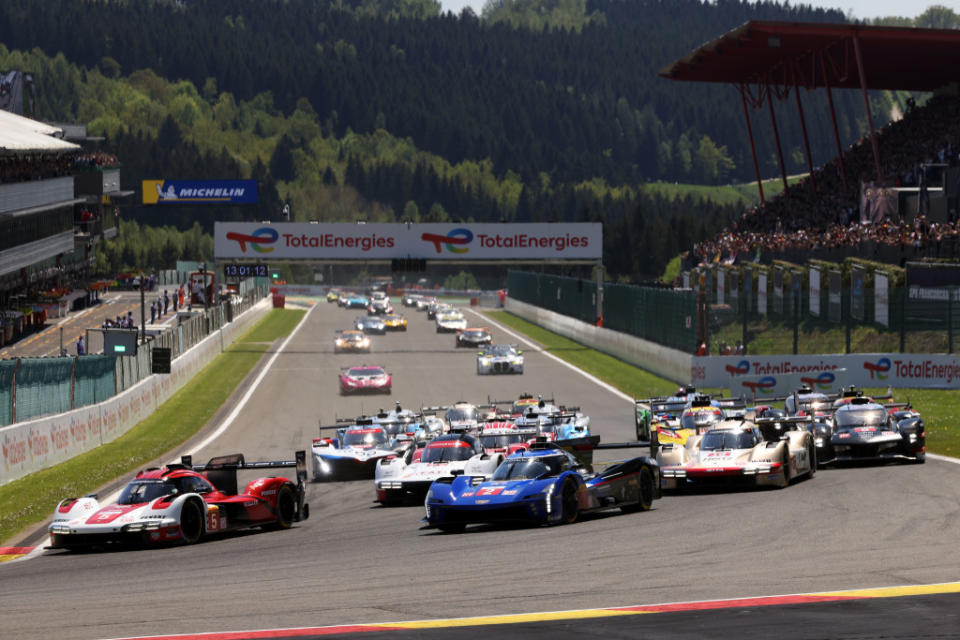LMP2 at the crossroads

Less than two years out from the expected debut of the next generation of LMP2 cars at the 2026 edition of the Rolex 24 At Daytona, the shape of the future ruleset for the category has never been more uncertain.
As it stands right now, LMP2 grids around the world are huge and are packed with high quality teams and drivers, with 22 cars racing in the European Le Mans Series and a further 11 in IMSA. And that’s before you look at the strong fields produced for the Asian Le Mans Series each winter.
But the current regulation set is heading towards the end of its life. Publicly, the plan is for a 2026 debut for the new-look cars that will be Gibson-powered and based on spines from LMDh chassis manufacturers. However, it’s not that simple.
It has become clear that the proposed timeline towards 2026 has never been set in stone, and still isn’t. In fact, it appears at present that a delay to the regulations being introduced is the most likely scenario, though how long that will be is not yet known.
There are signs that we are close to a final decision, but paddock sources in the LMP2 marketplace have suggested to RACER repeatedly that the situation remains fluid.
So how did we reach this point?
Around the time of the Sebring 12 Hours, RACER’s sources held that the new rules were still on track for 2026, though only the ELMS (and Le Mans) would adopt them. Instead, because of the complexities of the racing calendar, IMSA and the Asian Le Mans Series would wait until 2027 to introduce the new-look cars.
In IMSA’s case, using next-gen LMP2 cars in ’26 would mean a debut in January at the Rolex 24, shortening the timeframe for manufacturers to deliver cars to customers. It would also place the burden of debuting the new cars at a 24-hour race not organized by the governing body that controls the rules.
And in the case of the Asian Le Mans Series, should the calendar format remain the same by that point, the introduction would come halfway through the 2025/26 season. That’s not at all practical.
This consensus appeared to have changed by the week of the 2024 ELMS season opener in Barcelona in April. One source told RACER that “a total delay to 2027 or beyond seemed almost inevitable,” with an announcement expected imminently. That never came, though, and a technical working group meeting planned around the Paul Ricard round was understood to have been postponed following a significant meeting held elsewhere. This left the four LMP2 manufacturers and cabal of current teams to ponder whether or not this meant the ruleset would be delivered as planned for 2026.
Either way, the length of time it’s taking to draw up the ruleset is proving to be a source of frustration for just about everyone involved. There is a framework that is near-completion, with itemized costs and peripheral overarching regulations, meaning the green light could be given on short notice, depending on the ongoing tender for electronics coming to a close. But crucially, nothing has been signed off.
Therefore, with each week that passes without a decision, a 2026 debut for the new cars seems less likely. A delay to 2027 appears to be the most realistic scenario but still, a decision needs to come soon.
If everything is to come together for 2026, as planned, the manufacturers need to know how much time they have to play with to finish development work and build up a stock of cars to sell for Year 1. The teams also need time to make the sums work, too.
Is it still possible for the manufacturers to finish designing and building cars in time for 2026 at this point? The answer appears to be yes, though it would be extremely challenging and the feeling is that a firm decision needs to be made before the Le Mans 24 Hours gets underway next month.
The timeline of the new regulations may be the most pressing issue right now, but the actual ruleset being formed and the cost of the cars the teams will be investing in, is the crux of this story.
If forced, there will be teams that will come along for the ride come what may, in part because, as RACER has been told clearly by a senior source close to the ruleset, there will be at least 15 LMP2 spaces on the grid at Le Mans “indefinitely.” That is welcome news for teams and the future of the category. As long as entries for that race are on offer, teams will work overtime to make the sums work.
Bang for the buck…er, Euro, has always been key to the appeal of LMP2 the world over, and the new rules will aim to keep the costs from spiraling. Motorsport Images
So what do we know about the new cars?
RACER has seen a breakdown of cost-capped parts for the cars and what stood out was the overall cost per car, which has been placed at a level not dramatically different to the current ruleset.
The car itself, including electronics (an exact figure isn’t yet available for that element as the tender is ongoing), is expected to be around 560-600,000 Euros ($609-653K). This means that teams are looking at roughly a million Euros per car, with spares. That may sound eye-watering, but an ORECA 07 without an engine, electronics kit or spares, right now will set you back 525,000 Euros ($571K). This is the current price following the permitted rise above the original capped cost to offset inflation.
Looking at the specific elements with costs placed on them, some are supposedly going to be capped at a lower price than the current formula. For instance, a front bodywork assembly is believed to be priced at 38,000 Euros, when it’s 50,000 now.
Another key element of the new ruleset, in which all four manufacturers (ORECA, Ligier, Dallara and Multimatic) are expected to produce cars for customers, is that there will be no Balance of Performance. At least not in a traditional sense. Instead, they will be homologated to sit inside a defined performance window — like LMDh cars right now. And, to keep all four manufacturers in the formula long-term and prevent the current situation (where almost every team competes with ORECA because it’s considered the best car) from re-occurring, a bi-annual “Adjustment of Performance” will be made. This will balance their weight and power. Is this “BoP” under a different guise? We will have to wait and see.
Going into further detail, the radiator dimensions will be mandated and each team will be forced to run to a compulsory ride height level, primarily to increase the life of specific components such as the splitter. Certain parts will also be designed to meet regulations that define specific areas permitted to experience “excessive” amounts of wear.
The weight of the cars is expected to come in lighter than current Hypercars but heavier than current P2s, at 980kg. There will be one homologated body kit for the cars globally and they will be expected to run to the same performance level as the current LMP2 cars at Le Mans. It seems this particular aspect is up for debate, though, as RACER has been given conflicting answers by sources close to the ruleset.
Beyond all this, the scope for the manufacturers to go in different directions conceptually has been squeezed further. They will run with spec exhausts, spec electronics, a spec gearbox and a spec engine from Gibson.
As for tires, Goodyear is set to supply spec compounds to the class in the ELMS and Le Mans through the start of the new era. Currently, the molds for the new sizes (that mirror LMDh tire sizes) have been produced, the first iteration of the tires has been prepped, simulation work is ongoing and Goodyear has told RACER that it will be ready to supply product to manufacturers for the start of track testing as soon as Q1 of 2025.
Michelin, meanwhile, already supplies tires for LMDh. It is ahead of the curve in that sense for its future LMP2 commitments in IMSA and the Asian Le Mans Series.
All this comes together to form the regulations for the new cars, in which the four manufacturers will be pitted against one another to secure customers.
Ensuring a return on investment may prove extremely tough. There is money to be made on spares, but the fight to get customers to commit will be fierce from all sides if they expect to turn a profit in the short to medium term.
A senior manufacturer representative told RACER, “We believe that to make our money back and begin to go into profit, we need to have six cars running over a five-year period.”
Is a five-year wait for a return on investment viable? Does it make sense for anyone other than ORECA and its bulging book of current customers? That is yet another complex element of this debate.
Speaking of ORECA — the dominant player in the current marketplace — it finds itself in an odd position.
On one hand, a delay to the ruleset would be beneficial as it would enable it to continue selling 07 chassis to its large customer base. On the other, it is actively developing its new LMP2 car, which will be based on the LMDh chassis used by Acura and Alpine in GTP and Hypercar.
ORECA is confident it will continue to offer the best product, is prepared to have a car on track testing during Q2/Q3 2025 should it need to and has already engaged with its current customers about its future position in the LMP2 market. In the background it is also working on an outline production plan, which will likely need to be scaled up from 10 cars per year to meet demand.
The ORECA 07 Gibson has been the dominant LMP2 player, but is not opposed to a new ruleset. Jakob Ebrey/Motorsport Images
The other three manufacturers appear to hold mixed feelings. Ligier is keen to return to the sharp end of LMP2 as soon as possible, alongside its dominant position in the LMP3 sphere and involvement with Lamborghini in LMDh.
In general, it is believed to be pushing hardest for a 2026 debut. Dallara and Multimatic, on the other hand, have been described by teams as “more relaxed,” leaving Ligier as a lone voice pushing hard to move the ruleset along.
However, despite rumors suggesting otherwise, Multimatic and Dallara are known to be fully engaged in the process and just as serious about re-entering the marketplace; the difference is they are less worried about the timeline.
Pierre Nicolet, the CEO of Ligier Automotive, was the only representative from a manufacturer prepared to go on the record for this story.
“We are committed to the ruleset, and to 2026 should it happen,” he told RACER. “The CFD work has started, we have new staff dedicated to delivering it and everything is in place for the start of racetrack development by the end of Q1 2025, ahead of an anticipated homologation for the latter part of the year.
“In this case, we would be open for business, with 10 cars ready to sell in Year 1 to customers racing in ELMS, IMSA, Asia, anywhere the cars are able to race. We are ready.
“The new set of regulations strongly pushes to stop the cost escalation, with a cost cap on specific parts and an overall cost cap. The sporting regulations also prevent bodywork wear to prevent damage-related costs we see in the current regulation.”
The current strength of the Hypercar field has had a knock-on boost for LMP2, prompting LMP2 suppliers to suggest now is the time to move the class to a new ruleset. Motorsport Images
So what is the case for going ahead with 2026?
“The perfect time is now,” one source from an LMP2 supplier told RACER, because the marketplace is in such a strong position. If you change the ruleset as planned, they pointed out, the take-up will be strong purely because Hypercar is experiencing a boom” period, with manufacturers in record numbers and dozens of factory seats to fight for. The demand for race seats in LMP2 has never been so high because the top rung on the ladder has never been so attractive.
Delay the LMP2 ruleset and you risk introducing it at a time when the top class is either smaller, features fewer factory cars or is in a transition to new rules. This would make LMP2 a tougher sell. By bringing in next-gen P2 sooner rather than later, you allow time for the marketplace to settle before the top class moves into its next era.
This would also allow teams to race with cars based on LMDh chassis ahead of deciding whether or not to go racing in Hypercar or GTP in the future. Next-gen P2 is non-hybrid (and therefore more privateer friendly), but with the base chassis proposed, you could theoretically upgrade to an LMDh, or utilize any spare chassis that hasn’t been raced for future LMDh programs.
By delaying, you’re also putting off teams that are currently on the outside of LMP2 and looking in. Why buy an ORECA 07 now? It is unclear how much longer you can use it and the level is so high. Coming into a spec formula and trying to match teams that have been racing for almost a decade is beyond intimidating.
So, why delay the inevitable? Well, the most common response to any question asked to team managers about the future of LMP2 is a variation on: “It works so well. Why are they changing it?”
If a delay happens, the pushback from the teams in recent weeks as the future ruleset has become more of a pressing issue will be the key factor in the decision.
There are many reasons why teams are apprehensive to vote for change when things are so strong right now. However, it appears that some of the key fears are based on a lack of clarity rather than firm decisions.
That’s become an overarching theme. With no defined set of rules published and no delivery date to work towards, trying to unpick facts from rumors has been a real challenge.
This leaves us with the final item on the agenda: what a delay looks like and means for the future.
If 2026 is not delivered, then we will almost certainly see the new LMP2 cars debut between 2027 and 2030. Talks are ongoing in the background between the rule makers, suppliers and the current band of LMP2 teams. This, RACER understands, includes a survey that was sent to the ELMS teams after the last race in Barcelona, asking for opinions on the proposed new rules and a delay.
There is also talk of a conference-style meeting being organized by LMEM, which would allow the teams and all four manufacturers an open forum to discuss the new ruleset and answer key questions.
From the rule-maker side, it has become clear to RACER via background conversations that a concerted effort is being made to listen to current LMP2 teams over the key voices within the suppliers, as the overwhelming majority of them have made it clear that a delay is preferable. It is hard to justify ruling against them. The rule-makers are also keen to take into account the current financial situation globally and its impact on the sport at this level moving forward before making the final call.
Once we get into the weeds of 2027 and beyond, that would place the debut of the new LMP2 regulations during a transitional period for the top class, with hydrogen regulations on the agenda, along with a likely extension of the current Hypercar ruleset. Such wholesale change to the prototype marketplace in such a short space of time would surely bring with it an additional set of challenges.
A single-year delay seems most logical. But if opting for even more breathing room is the chosen route, it must be managed carefully.
Are the proposed regulations fully fit for purpose? Is there a case for a total “blank sheet of paper” rethink as has been suggested? What do the teams think? Are the suppliers happy and capable of delivering high-quality products in the time made available?
These are all questions that must be asked and answered to ensure the future ruleset for LMP2 is effective at delivering good racing, with cars that aren’t too expensive to buy and run.

 Yahoo Autos
Yahoo Autos 


